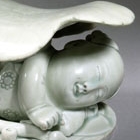J.J. Lally & Co., Oriental Art / New York City, New York
MenuPast Exhibition
Chinese Porcelain and Silver in the Song Dynasty
March 18 - April 8, 2002
20.
A YINGQING PORCELAIN ‘BOY AND LILYPAD’ PILLOW
Northern Song Dynasty (A.D. 960-1127)
sculpted in the form of a plump baby boy sleeping under a large lilypad, with his head resting on his arm, with eyes shut and a serene expression on his face, wearing slippers, baggy pants decorated with impressed ring motifs, and a short tunic decorated with florettes, with one small fist clenched above the end of a curling stalk which winds across his body and up to the wide quatrefoil lotus leaf which forms the headrest, incised with radiating veins extending out to the scalloped rim, the oval platform base decorated with overlapping leaf tips, all covered with a translucent pale bluish glaze which pools to deeper tones in the carved recesses, highlighting the details, the underside hollow in the center and the broad flat foot left unglazed showing the white porcelain body impressed with linen mesh on the base before firing.
Height 4 1⁄2 inches (11.4 cm)
Length 7 inches (17.8 cm)
An excavated example of this same distinctive model, but with the lotus leaf headrest broken off, was discovered at the Hutian kiln site in Jingdezhen, Jiangxi province and is illustrated in a color frontispiece of Wenwu, 2001, No. 2, as pl. 2, with a full report on the excavation by The Institute of Archaeology of Jiangxi and The Jingdezhen Museum of Ceramic History, entitled “Excavation of Section H of the Hutian Kiln Site at Jingdezhen, Jiangxi”, pp. 42-62, where the form is described as Northern Song type D pillow.
Gao Lian, in his influential treatise on connoisseurship and other cultural topics published in A.D. 1591, Ya Sang Zhai Zun Sheng Ba Jian (Eight Discourses on the Art of Living from the Studio where Elegance is Valued) mentions pillows in the form of a boy holding a lotus leaf.
